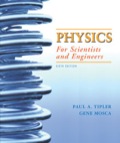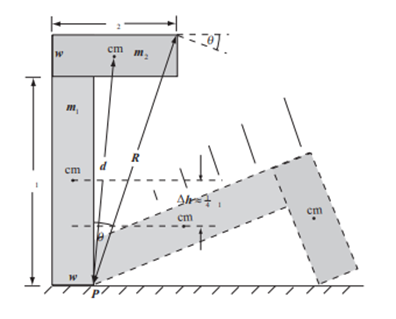
Concept explainers
(a)
To Calculate: The initial
(a)
Answer to Problem 118P
Explanation of Solution
Given information:
Height of each vertical beam
Width of each vertical beam
Length horizontal cross-member
The mass of the vertical beam
The mass of the horizontal beam
Formula Used:
From Newton’s second law of motion
Where, F is the net force, m is the mass and a is the acceleration.
Calculation:

Here, one of the structures initially in its upright position. But later, it is about to strike the floor. The moments about the axis of rotation (a line through point P) can be considered.
Use the parallel-axis theorem to find the moments of inertia of the two parts of this composite structure. Let the numeral 1 denote the vertical member and the numeral 2 the horizontal member.
Apply Newton’s second law of motion in rotational form to the structure to express its angular acceleration in terms of the net torque causing it to fall and its moment of inertia with respect to point P.
Taking clockwise rotation to be positive, use
Here,
The mass of the vertical beam =
mass of the horizontal beam =
Length of vertical beam =
Width of the beam =
Acceleration of the beam =
Gravitational acceleration =
Because
Conclusion:
The initial angular acceleration of the structure is
(b)
ToCalculate: The magnitude of the initial linear acceleration of the right end of the horizontal beam.
(b)
Answer to Problem 118P
Explanation of Solution
Given information:
Height of each vertical beam
Width of each vertical beam
Length horizontal cross-member
The mass of the vertical beam
The mass of the horizontal beam
The initial angular acceleration of the structure is
Formula used:
From Newton’s second law of motion
Where, F is the net force, m is the mass and a is the acceleration.
Linear acceleration (a) in terms of angular acceleration (
Calculation:

Conclusion:
The magnitude of the initial linear acceleration of the right end of the horizontal beam is
(c)
To explain: The horizontal component of the initial linear acceleration be at this same location.
(c)
Answer to Problem 118P
Explanation of Solution
Given information:
Height of each vertical beam
Width of each vertical beam
Length horizontal cross-member
The mass of the vertical beam
The mass of the horizontal beam
The magnitude of the initial linear acceleration of the right end of the horizontal beam is
Formula used:
Horizontal component of acceleration is
Calculation:
Conclusion:
The horizontal component of the initial linear acceleration be at this same location is
(d)
To Calculate: The beam’s rotational speed when they caught it.
(d)
Answer to Problem 118P
Explanation of Solution
Given information:
Height of each vertical beam
Width of each vertical beam
Length horizontal cross-member
The mass of the vertical beam
The mass of the horizontal beam
Formula used:
Rotational kinetic energy:
Where, I is the moment of inertia and
Potential energy,
Where, m is the mass, g is the acceleration due to gravity and h is the height.
Calculation:
By applying the conservation of mechanical energy to the beam:
Conclusion:
The beam’s rotational speed when they caught it is
Want to see more full solutions like this?
Chapter 9 Solutions
EBK PHYSICS FOR SCIENTISTS AND ENGINEER
- A meter stick is supported by a knife-edge at the 50-cm mark. You hang masses of 0.40 kg and 0.60 kg from the 20-cm and 80-cm marks, respectively. Where should you hang a third mass of 0.30 kg to keep the stick balanced?arrow_forwardA 85-kg man starts climbing a ladder that leans against a wall as shown in the diagram. If the ladder is 5 m long and weighs 10 kg, determine the normal reaction at the horizontal surface (in N) if the coefficient of friction is 0.25 at the top vertical surface and 0.4 at the bottom horizontal surface.arrow_forwardIn the figure a 50 kg rock climber is in a lie-back climb along a fissure, with hands pulling on one side of the fissure and feet pressed against the opposite side. The fissure has width w = 0.20 m, and the center of mass of the climber is a horizontal distance d = 0.45 m from the fissure. The coefficient of static friction between hands and rock is μ1 = 0.50, and between boots and rock it is μ2 = 1.15. The climber adjusts the vertical distance h between hands and feet until the (identical) pull by the hands and push by the feet is the least that keeps him from slipping down the fissure. (He is on the verge of sliding.) (a) What is the least horizontal pull by the hands and push by the feet that will keep the climber stable? (b) What is the value of h?arrow_forward
- Consider the following distribution of objects: a 4.00-kg object with its center of gravity at (0, 0) m, a 1.20-kg object at (0, 3.00) m, and a 3.40-kg object at (4.00, 0) m. Where should a fourth object of mass 6.00 kg be placed so that the center of gravity of the four-object arrangement will be at (0, 0)?arrow_forwardConsider the following mass distribution where the x- and y-coordinates are given in meters: 5.0 kg at (0.0, 0.0) m, 3.4 kg at (0.0, 4.8) m, and 4.0 kg at (3.4, 0.0) m. Where should a fourth object of 9.0 kg be placed so that the center of gravity of the four-object arrangement will be at (0.0, 0.0) m?arrow_forwardThe center of mass of a rigid body always lies inside the body. Is this statement true or false? Why?arrow_forward
- In the figure, a lead brick rests horizontally on cylinders A and B. The areas of the top faces of the cylinders are related by AA= 1.7 AB; the Young's moduli of the cylinders are related by EA= 1.9 EB. The cylinders had identical lengths before the brick was placed on them. What fraction of the brick's mass is supported (a) by cylinder A and (b) by cylinder B? The horizontal distances between the center of mass of the brick and the centerlines of the cylinders are dAfor cylinder A and dB for cylinder B. (c) What is the ratio dA/dB?arrow_forwardTwo girls, X and Y, are seated on identical skateboards on a smooth, horizontal surface. The masses of the girls are 60 kg and 50 kg, respectively. If girl X pushes hard to the right with her feet on girl Y, what will happen?arrow_forwarda horizontal scaffold, of length 2.00 m and uniform mass 50.0 kg, is suspended from a building by two cables. The scaffold has dozens of paint cans stacked on it at various points. The total mass of the paint cans is 75.0 kg. The tension in the cable at the right is 722 N. How far horizontally from that cable is the center of mass of the system of paint cans?arrow_forward
- Biomechanically, what is the significance and importance of the center of gravity when performing a kick out exercise?arrow_forwardA uniform density sheet of metal is cut into the shape of an isosceles triangle, which is oriented with the base at the bottom and a corner at the top. It has a base B = 13 cm, height H = 19 cm, and area mass density σ. e) Set up an integral to calculate the vertical center of mass of the triangle, assuming it will have the form C ∫ f(y) where C has all the constants in it and f(y) is a function of y. What is f(y)? f)Integrate to find an equation for the location of the center of mass in the vertical direction. Use the coordinate system specified in the previous parts, with the origin at the top and positive downward. g) Find the numeric value for the distance between the top of the triangle and the center of mass in cm.arrow_forwardConsider the following mass distribution where the x- and y-coordinates are given in meters: 5.0 kg at (0.0, 0.0) m, 2.5 kg at (0.0, 3.9) m, and 4.0 kg at (3.2, 0.0) m. Where should a fourth object of 9.4 kg be placed so that the center of gravity of the four-object arrangement will be at (0.0, 0.0) m? x = y =arrow_forward
 College PhysicsPhysicsISBN:9781938168000Author:Paul Peter Urone, Roger HinrichsPublisher:OpenStax College
College PhysicsPhysicsISBN:9781938168000Author:Paul Peter Urone, Roger HinrichsPublisher:OpenStax College
